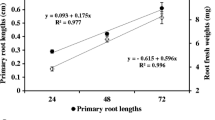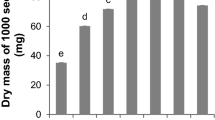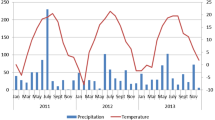Abstract
The aim of this study was to investigate the phytotoxic effect of sunflower on physiological and biochemical processes during germination of mustard seeds (Sinapis alba L. cv. Nakielska). To exclude the involvement of osmotic stress in seed reaction to phytotoxic compounds, we compared the effect of 10% (w/v) water extract from sunflower (Helianthus annuus L. cv. Ogrodowy) leaves and 28.4% (w/v) polyethylene glycol (PEG) 8000 solution characterized by an equal Ψ = −1 MPa. We evaluated (1) the amount of hydrogen peroxide (H2O2); (2) activities of antioxidant enzymes: superoxide dismutase, catalase, and glutathione reductase; (3) membrane permeability; and (4) level of malondialdehyde (MDA). Both, sunflower compounds and PEG solutions inhibited mustard seed germination, but only phytotoxins caused an increase in the cell membrane permeability, MDA level, H2O2 concentration, and alterations in activities of antioxidant enzymes. Our results demonstrate that despite the activation of the antioxidant system by sunflower phytotoxins, reactive oxygen species accumulation caused cellular damage, which resulted in the decrease of germinability and gradual loss of seed vigor. It seems that the negative effect of sunflower on germination of mustard seeds is mostly because of its toxicity and not to its contribution to osmotic potential.





Similar content being viewed by others
References
Abrahim, D., Braguini, W. L., Kelmer-Bracht, A. M., and Ishii-Iwamoto, E. L. 2000. Effects of four monoterpenes on germination, primary root growth, and mitochondrial respiration of maize. J. Chem. Ecol. 26:611–624.
Anaya, A. L. and Pelayo-Benavides, H. P. 1997. Allelopathic potential of Mirabilis jalapa L. (Nyctaginaceae): Effects on germination, growth and cell division of some plants. Allelopathy J. 4:57–68.
Apel, K. and Hirt, H. 2004. Reactive oxygen species: Metabolism, oxidative stress and signal transduction. Annu. Rev. Plant Biol. 55:373–399.
Azania, A. A. P. M., Azania, C. A. M., Alves, P. L. C. A., Palaniraj, R., Kadian, H. S., Sati, S. C., Rawat, L. S., Dahiya, D. S., and Narwal, S. S. 2003. Allelopathic plants. Sunflower (Helianthus annuus L.). Allelopathy J. 11:1–20.
Bailly, C., Benamar, A., Corbineau, F., and Côme, D. 1996. Changes in malondialdehyde content and in superoxide dismutase, catalase and glutathione reductase activities in sunflower seeds as related to deterioration during accelerated aging. Physiol. Plant. 97:104–110.
Bais, H. P., Vepachedu, R., Gilroy, S., Callaway, R. M., and Vivanco, J. M. 2003. Allelopathy and exotic plant invasion: from molecules and genes to species interactions. Science 301:1377–1380.
Batish, D. R., Tung, P., Singh, H. P., and Kohli, R. K. 2002. Phytotoxicity of sunflower residues against some summer season crops. J. Agron. Crop Sci. 188:19–24.
Blokhina, O., Virolainen, E., and Fagersted, K. V. 2003. Antioxidants, oxidative damage and oxygen deprivation stress: a review. Ann. Bot. 91:179–194.
Bogatek, R., Gniazdowska, A., Zakrzewska, W., Oracz, K., and Gawroñski, S. W. 2006. Allelopathic effect of sunflower extracts on mustard seed germination and seedling growth. Biol. Plant. 50:156–158.
Bowler, C., Montagu, M. V., and Inze, D. 1992. Superoxide dismutase and stress tolerance. Annu. Rev. Plant Physiol. Plant Mol. Biol. 43:83–116.
Bradford, M. M. 1976. A rapid and sensitive method for the quantitation of microgram quantities of protein utilizing the principle of protein-dye binding. Anal. Biochem. 72:248–254.
Clairbone, A. 1985. Catalose activity, pp. 283–284, in R. A. Greenwald (ed.). Handbook of Methods of Oxygen Radical Research. CRC Press, Boca Raton, FL.
Cruz-Ortega, R., Anaya, A. L., and Ramos, L. 1988. Effects of allelopathic compounds of corn pollen on respiration and cell division of watermelon. J. Chem. Ecol. 14:71–86.
Cruz-Ortega, R., Anaya, A. L., Gavilanes-Ruiz, M., Sánchez-Nieto, S., and Jimmenez-Estrada, M. 1990. Effect of diacetyl piquerol on the H+-ATPase activity of microsomes from Ipomoea purpurea. J. Chem. Ecol. 16:2253–2261.
Cruz-Ortega, R., Ayala-Cordero, G., and Anaya, L. A. 2002. Allelochemical stress produced by aqueous leachate of Callicarpa acuminata: effects on roots of bean, maize, and tomato. Physiol. Plant. 116:20–27.
Czarnota, M. A., Paul, R. N., Dayan, F. E., Nimbal, C. I., and Weston, L. A. 2001. Mode of action, localization of production, chemical nature and activity of sorgoleone: A potent PSII inhibitor in Sorghum spp. root exudates. Weed Technol. 15:813–825.
Dayan, F. E., Romagni, J. G., and Duke, S. O. 2000. Investigating the mode of action of natural phytotoxins. J. Chem. Ecol. 26:2079–2094.
De Gara, L., De Pinto, M. C., and Tommasi, F. 2003. The antioxidant systems vis-a-vis reactive oxygen species during plant-pathogen interaction. Plant Physiol. Biochem. 41:863–870.
Del Rio, L. A., Corpas, F. J., Sandalio, L. M., Palma, J. M., Gomez, M., and Barroso, J. B. 2002. Reactive oxygen species, antioxidant systems and nitric oxide in peroxisomes. J. Exp. Bot. 53:1255–1272.
Foyer, C. H. and Noctor, G. 2003. Redox sensing and signalling, associated with reactive oxygen in chloroplasts, peroxisomes and mitochondria. Physiol. Plant. 119:355–364.
Foyer, C. H. and Noctor, G. 2005. Oxidant and antioxidant signalling in plants: a re-evaluation of the concept of oxidative stress in a physiological context. Plant Cell Environ. 28:1056–1071.
Foyer, C. H., Descourvieres, P., and Kunert, K. J. 1994. Protection against oxygen radicals: an important defence mechanism studied in transgenic plants. Plant Cell Environ. 17:507–523.
Foyer, C. H., Souriau, N., Perret, S., Lelandis, M., Kunert, K. J., Pruvost, C., and Jouanin, L. 1995. Overexpression of glutathione reductase but not glutathione synthetase leads to increase in antioxidant capacity and resistance to photoinhibition in poplar trees. Plant Physiol. 109:1047–1057.
Galindo, J. C. G., Hernandez, A., Dayan, F. E., Tellez, M. R., Macias, F. A., Paul, R. N., and Duke, S. O. 1999. Dehydrozaluzanin C, a natural sesquiterpenolide, causes rapid plasma membrane leakage. Phytochemistry 52:805–813.
Giannopolitis, C. N. and Ries, S. K. 1977. Superoxide dismutases I. Occurrence in higher plants. Plant Physiol. 59:309–314.
Gniazdowska, A. and Bogatek, R. 2005. Allelopathic interactions between plants. Multi site action of allelochemicals. Acta Physiol. Plant. 27:395–407.
Goel, A., Goel, A. K., and Sheoran, I. S. 2003. Changes in oxidative stress enzymes during artificial ageing in cotton (Gossypium hirsutum L.) seeds. J. Plant Physiol. 160:1093–1100.
Heath, R. L. and Parker, L. 1968. Photoperoxidation in isolated chloroplasts. I. Kinetics and stoichiometry of fatty acid peroxidation. Arch. Biochem. Biophys. 125:189–198.
Inze, D. and Montagu, V. 1995. Oxidative stress in plants. Curr. Opin. Biotechnol. 6:153–158.
Irons, S. and Burnside, O. C. 1982. Competitive and allelopathic effect of sunflower (Helianthus annuus). Weed Sci. 30:372–377.
Kato-Noguchi, H. and Tanaka, Y. 2003–2004. Effects of capsaicin on plant growth. Biol. Plant. 47:157–159.
Kupidłowska, E., Gniazdowska, A., Stępień, J., Corbineau, F., Vinel, D., Skoczowsk, A., Janeczko, A., and Bogatek, R. 2006. Impact of sunflower (Helianthus annuus L.) extracts upon reserve mobilization and energy metabolism in germinating mustard (Sinapis alba L.) seeds. J. Chem. Ecol. DOI 10.1007/s10886-006-9183-z.
Leather, G. R. 1983. Sunflowers (Helianthus annuus) are allelopathic to weeds. Science 31:37–42.
Lehman, M. E. and Blum, U. 1999. Evaluation of ferulic acid uptake as a measurement of allelochemical dose: effective concentration. J. Chem. Ecol. 25:2585–2600.
Macias, F. A., Varela, R. M., Torres, A., and Molinillo, J. M. G. 1993. Potential allelopathic guaianolides from cultivar sunflower leaves, var. SH-222. Phytochemistry 34:669–674.
Macias, F. A., Varela, R. M., Torres, A., and Molinillo, J. M. G. 1996. Potential allelopathic sesquiterpene lactones from sunflower leaves. Phytochemistry 43:1205–1215.
Macias, F. A., Varela, R. M., Torres, A., Oliva, R. M., and Molinillo, J. M. G. 1997. Bioactive norsesquiterpenes from Helianthus annuus with potential allelopathic activity. Phytochemistry 48:631–636.
Macias, F. A., Oliva, R. M., Varela, R. M., Torres, A., and Molinillo, J. M. G. 1999. Allelochemicals from sunflower leaves cv. Peredovick. Phytochemistry 52:613–621.
Macias, F. A., Varela, R. M., Torres, A., and Molinillo, J. M. G. 2000. Potential allelopathic activity of natural plant heliannanes: a proposal of absolute configuration and nomenclature. J. Chem. Ecol. 26:2173–2186.
Macias, F. A., Varela, R. M., Torres, A., Galindo, J. L. G., and Molinillo, J. M. G. 2002. Allelochemicals from sunflowers: chemistry, bioactivity and applications, pp. 73–87, in Inderjit and A. U. Mallik (eds.). Chemical Ecology of Plants: Allelopathy in Aquatic and Terrestrial Ecosystems. Birkhauser Verlag, Basel.
Maffei, M., Bertea, C. M., Garneri, F., and Scanneri, S. 1999. Effect of benzoic acid hydroxy- and methoxy-ring substituents during cucumber (Cucumis sativus L.) germination. I. Isocitrate lyase and catalase activity. Plant Sci. 141:139–147.
Mittler, R. 2002. Oxidative stress, antioxidants and stress tolerance. Trends Plant Sci. 7:405–409.
Moore, R. P. 1973. Tetrazolium staining for assessing seed quality, pp. 347–366, in W. Heydecker (ed.). Seed Ecology. Butterworths, London.
Musculo, A., Panuccio, M. R., and Sidari, M. 2001. The effect of phenols on respiratory enzymes in seed germination. Respiratory enzyme activities during germination of Pinus laricio seeds treated with phenols extracted from different forest soils. Plant Growth Regul. 35:31–35.
O’Kane, D., Gill, V., Boyd, P., and Burdon, R. 1996. Chilling, oxidative stress and antioxidant responses in Arabidopsis thaliana callus. Planta 198:371–377.
Peng, S. L., Wen, J., and Guo, Q. F. 2004. Mechanism and active variety of allelochemicals. Acta Bot. Sin. 46:757–766.
Peñuelas, J., Ribas-Carbo, M., and Giles, L. 1996. Effect of allelochemicals on plant respiration and oxygen isotope fractionation by alternative oxidase. J. Chem. Ecol. 22:801–805.
Politycka, B. 1996. Peroxidase activity and lipid peroxidation in roots of cucumber seedlings influenced by derivatives of cinnamic and benzoic acids. Acta Physiol. Plant. 18:365–370.
Politycka, B. 1998. Phenolics and the activities of phenylalanine ammonia-lyase, phenol-β-glucosyltransferase and β-glucosidase in cucumber roots as affected by phenolics allelochemicals. Acta Physiol. Plant. 20:405–410.
Romero-Romero, T., Sanchez-Nieto, S., San Juan-Badillo, A., Anaya, A. L., and Cruz-Ortega, R. 2005. Comparative effects of allelochemical and water stress in roots of Lycopersicon esculentum Mill. (Solanaceae). Plant Sci. 168:1059–1066.
Scandalios, J. G. 1993. Oxygen stress and superoxide dismutase. Plant Physiol. 101:7–12.
Scandalios, J. G., Guan, L., and Polidoros, A. N. 1997. Catalases in plants: gene structure, properties, regulation and expression, pp. 343–406, in J. G. Scandalios (ed.). Oxidative Stress and the Molecular Biology of Antioxidant Defences. Cold Spring Harbor Laboratory Press, New York.
Scebba, F., Sebastiani, L., and Vitagliano, C. 1998. Changes in activity of antioxidative enzymes in wheat (Triticum aestivum) seedling under cold acclimation. Physiol. Plant. 104:747–752.
Shon, M. K. and Einhellig, F. A. 1982. Allelopathic effects of cultivated sunflower on grain sorghum. Bot. Gaz. 143:505–510.
Vranova, E., Inze, D., and van Breusegem, F. 2002. Signal transduction during oxidative stress. J. Exp. Bot. 53:1227–1236.
Weir, T. L., Park, S.-W., and Vivanco, J. M. 2004. Biochemical and physiological mechanisms mediated by allelochemicals. Curr. Opin. Plant Biol. 7:472–479.
Wilson, R. E. and Rice, E. L. 1968. Allelopathy as expressed by Helianthus annuus and its role in old-field succession. Bull. Torrey Bot. Club 95:432–448.
Yu, J. Q., Ye, S. F., Zhang, M. F., and Hu, W. H. 2003. Effects of root exudates and aqueous root extracts of cucumber (Cucumis sativus) and allelochemicals, on photosynthesis and antioxidant enzymes in cucumber. Biochem. Syst. Ecol. 31:129–139.
Zeng, R. S., Luo, S. M., Shi, Y. H., Shi, M. B., and Tu, C. Y. 2001. Physiological and biochemical mechanism of allelopathy of secalonic acid F on higher plants. Agron. J. 93:72–79.
Acknowledgements
We thank Stewart A. Brown, Professor Emeritus of Trent University, Peterborough, Ontario, Canada for assistance in preparing the English version of the manuscript.
Author information
Authors and Affiliations
Corresponding author
Rights and permissions
About this article
Cite this article
Oracz, K., Bailly, C., Gniazdowska, A. et al. Induction of Oxidative Stress by Sunflower Phytotoxins in Germinating Mustard Seeds. J Chem Ecol 33, 251–264 (2007). https://doi.org/10.1007/s10886-006-9222-9
Received:
Accepted:
Published:
Issue Date:
DOI: https://doi.org/10.1007/s10886-006-9222-9




